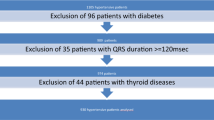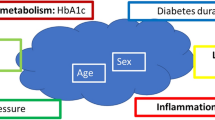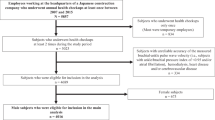Abstract
Although elevated blood pressure results in arterial stiffening, the converse could also be true. Previous studies have suggested that increased arterial stiffness precedes the development of hypertension. Since central blood pressure is augmented following arterial stiffening, the predictive value of central blood pressure for detecting new-onset hypertension was investigated in the general population. A total of 7840 normotensive subjects (male, 4592; mean age, 51 years) were followed up for a median of 4 years, with the endpoint being the development of hypertension. During the actual follow-up period of 31636 person-years, hypertension developed in 2608 subjects. Kaplan–Meier analysis revealed an increase in the risk of hypertension across the quartiles of baseline central blood pressure (log-rank P < 0.001), with incidence rates of hypertension in the first, second, third, and fourth quartiles of 8.8%, 22.3%, 39.9%, and 63.2%, respectively. Multivariate Cox hazard analysis demonstrated an increased hazard ratio of incident hypertension across the quartiles after adjustment for possible factors. Repeating the multivariate Cox hazard analysis with central blood pressure as a continuous variable also identified central blood pressure at baseline as a significant predictor of new-onset hypertension (P < 0.001). These results suggest that central blood pressure is a significant predictor of new-onset hypertension in individuals without hypertension.
This is a preview of subscription content, access via your institution
Access options
Subscribe to this journal
Receive 12 print issues and online access
$259.00 per year
only $21.58 per issue
Buy this article
- Purchase on Springer Link
- Instant access to full article PDF
Prices may be subject to local taxes which are calculated during checkout

Similar content being viewed by others
References
Kannel WB. Hypertension as a risk factor for cardiac events: epidemiologic results of long-term studies. J Cardiovasc Pharm. 1993;21:S27–37.
Umemura S, Arima H, Arima S, Asayama K, Dohi Y, Hirooka Y. et al. The Japanese society of hypertension guidelines for the management of hypertension (JSH 2019). Hypertens Res. 2019;42:1235–481.
Asayama K, Ohkubo T, Yoshida S, Suzuki K, Metoki H, Harada A.Japan Arteriosclerosis Longitudinal Study (JALS) group et al. Stroke risk and antihypertensive drug treatment in the general population: the Japan arteriosclerosis longitudinal study. J Hypertens. 2009;27:357–64.
Yano K, McGee D, Reed DM. The impact of elevated blood pressure upon 10-year mortality among Japanese men in Hawaii: the Honolulu Heart Program. J Chronic Dis. 1983;36:569–79.
Whelton PK, He J, Appel LJ, Cutler JA, Havas S, Kotchen TA.National High Blood Pressure Education Program Coordinating Committee. et al. Primary prevention of hypertension: clinical and public health advisory from The National High Blood Pressure Education Program. JAMA. 2002;288:1882–8.
Julius S, Nesbitt SD, Egan BM, Weber MA, Michelson EL, Kaciroti N.Trial of Preventing Hypertension (TROPHY) Study Investigators. et al. Feasibility of treating prehypertension with an angiotensin-receptor blocker. N. Engl J Med. 2006;354:1685–97.
Tissot AC, Maurer P, Nussberger J, Sabat R, Pfister T, Ignatenko S. et al. Effect of immunisation against angiotensin II with CYT006-AngQb on ambulatory blood pressure: a double-blind, randomised, placebo-controlled phase IIa study. Lancet. 2008;371:821–7.
Williams B, Lacy PS, Thom SM, Cruickshank K, Stanton A, Collier D.CAFE Investigators; Anglo-Scandinavian Cardiac Outcomes Trial Investigators; CAFE Steering Committee and Writing Committee. et al. Differential impact of BP-lowering drugs on central aortic pressure and clinical outcomes: principal results of the Conduit Artery Function Evaluation (CAFE) study. Circulation. 2006;113:1213–25.
Wang KL, Cheng HM, Chuang SY, Spurgeon HA, Ting CT, Lakatta EG. et al. Central or peripheral systolic or pulse pressure: which best relates to target organs and future mortality?. J Hypertens. 2009;27:461–7.
Roman MJ, Okin PM, Kizer JR, Lee ET, Howard BV, Devereux RB. Relations of central and brachial blood pressure to left ventricular hypertrophy and geometry: the Strong Heart Study. J Hypertens. 2010;28:384–8.
Yamashita S, Dohi Y, Takase H, Sugiura T, Ohte N. Central blood pressure reflects left ventricular load, while brachial blood pressure reflects arterial damage. Blood Press. 2014;23:356–62.
Tanaka S, Sugiura T, Yamashita S, Dohi Y, Kimura G, Ohte N. Differential response of central blood pressure to isometric and isotonic exercises. Sci Rep. 2014;4:5439.
Angeli F, Reboldi G, Trapasso M, Aita A, Verdecchia P. Gathering evidence on the prognostic role of central blood pressure in hypertension. Hypertens Res. 2018;41:865–8.
Eguchi K, Miyashita H, Takenaka T, Tabara Y, Tomiyama H, Dohi Y.ABC-J II Investigator Group. et al. High central blood pressure is associated with incident cardiovascular events in treated hypertensives: the ABC-J II Study. Hypertens Res. 2018;41:947–56.
Takazawa K, Kobayashi H, Shindo N, Tanaka N, Yamashina A. Relationship between radial and central arterial pulse wave and evaluation of central aortic pressure using the radial arterial pulse wave. Hypertens Res. 2007;30:219–28.
Takase H, Dohi Y, Kimura G. Distribution of central blood pressure values estimated by Omron HEM-9000AI in the Japanese general population. Hypertens Res. 2013;36:50–7.
Nichols WW. Clinical measurement of arterial stiffness obtained from noninvasive pressure waveforms. Am J Hypertens. 2005;18:3S–10S.
Nichols WW, Denardo SJ, Wilkinson IB, McEniery CM, Cockcroft J, O’Rourke MF. Effects of arterial stiffness, pulse wave velocity, and wave reflections on the central aortic pressure waveform. J Clin Hypertens (Greenwich). 2008;10:295–303.
Gavish B, Izzo JL Jr. Arterial stiffness: going a step beyond. Am J Hypertens. 2016;29:1223–33.
O’Rourke MF, Nichols WW. Aortic diameter, aortic stiffness, and wave reflection increase with age and isolated systolic hypertension. Hypertension. 2005;45:652–8.
Mitchell GF. Arterial stiffness and hypertension: chicken or egg? Hypertension. 2014;64:210–4.
Kaess BM, Rong J, Larson MG, Hamburg NM, Vita JA, Levy D. et al. Aortic stiffness, blood pressure progression, and incident hypertension. JAMA. 2012;308:875–81.
AlGhatrif M, Strait JB, Morrell CH, Canepa M, Wright J, Elango P. et al. Longitudinal trajectories of arterial stiffness and the role of blood pressure: the Baltimore Longitudinal Study of Aging. Hypertension. 2013;62:934–41.
Tomiyama H, Townsend RR, Matsumoto C, Kimura K, Odaira M, Yoshida M. et al. Arterial stiffness/central hemodynamics, renal function, and development of hypertension over the short term. J Hypertens. 2014;32:90–9.
Sugiura T, Dohi Y, Takase H, Ito A, Fujii S, Ohte N. Differential effects of brachial and central blood pressures on circulating levels of high-sensitivity cardiac troponin I in the general population. Atherosclerosis. 2018;269:185–91.
Takase H, Sugiura T, Murai S, Yamashita S, Ohte N, Dohi Y. Use of electrocardiography to predict future development of hypertension in the general population. Med (Baltim). 2016;95:e3483.
Takase H, Sugiura T, Murai S, Yamashita S, Ohte N, Dohi Y. Carotid intima-media thickness is a novel predictor of new onset of hypertension in normotensive subjects. Med (Baltim). 2017;96:e7710.
Tomiyama H, O’rourke MF, Hashimoto H, Matsumoto C, Odaira M, Yoshida M. et al. Central blood pressure: a powerful predictor of the development of hypertension. Hypertens Res. 2013;36:19–24.
Heagerty AM, Heerkens EH, Izzard AS. Small artery structure and function in hypertension. J Cell Mol Med. 2010;14:1037–43.
Laurent S, Boutouyrie P. The structural factor of hypertension: large and small artery alterations. Circ Res. 2015;116:1007–21.
Author information
Authors and Affiliations
Corresponding author
Ethics declarations
Conflict of interest
The authors declare that they have no conflict of interest.
Additional information
Publisher’s note Springer Nature remains neutral with regard to jurisdictional claims in published maps and institutional affiliations.
Supplementary information
Rights and permissions
About this article
Cite this article
Sugiura, T., Takase, H., Machii, M. et al. Central blood pressure predicts the development of hypertension in the general population. Hypertens Res 43, 1301–1308 (2020). https://doi.org/10.1038/s41440-020-0493-2
Received:
Revised:
Accepted:
Published:
Issue Date:
DOI: https://doi.org/10.1038/s41440-020-0493-2
Keywords
This article is cited by
-
Association of central blood pressure with an exaggerated blood pressure response to exercise among elite athletes
European Journal of Applied Physiology (2024)
-
Vascular function: a key player in hypertension
Hypertension Research (2023)



